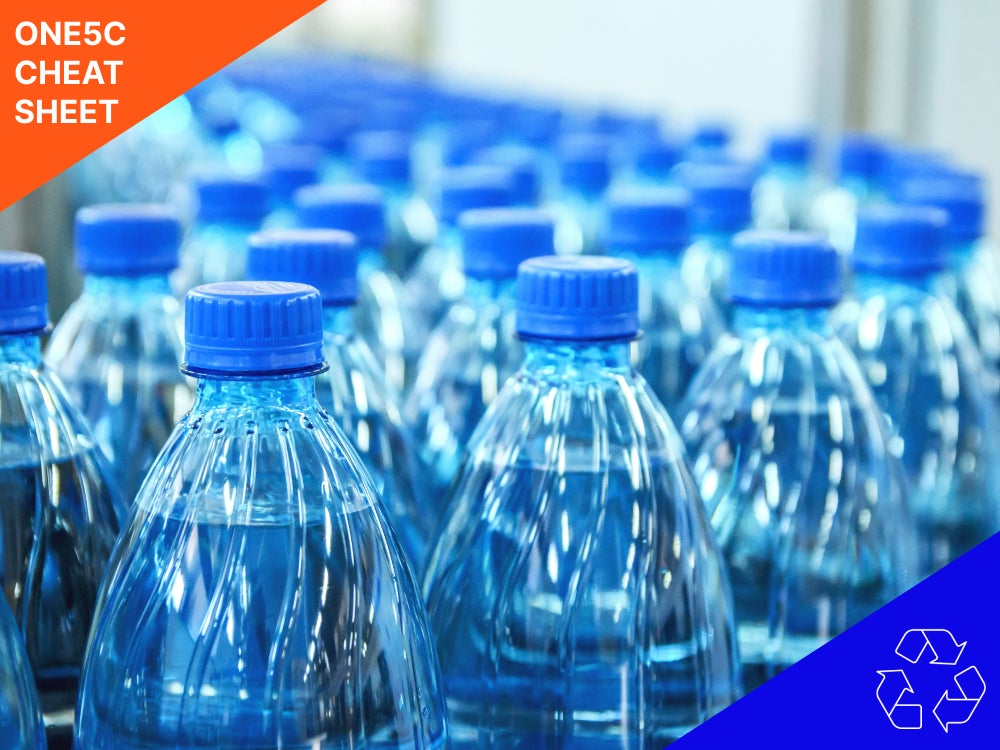Plastic pollution is a nightmare for the climate, ecosystems, agriculture, human health, and the oceans. All of our plastic wrap, bottles, bags, tools, toys, furniture, and other PET and polyester wares end up generating hundreds of millions of metric tons of plastic waste every year—and the problem is set to triple to one billion metric tons by 2060.1 Worldwide, a tiny fraction of that ends up being recycled, the rest is left to decompose over a span of anywhere from 10 to 500 years.
To protect our planet from waste, limit our reliance on climate-killing fossil fuels, and invigorate progress towards a circular economy, we must confront and correct our love affair with plastics. This slate of cheat sheets will help you understand the scale of the problem and what’s happening to fix it—from the broken promises of plastic recycling to the truth about the microplastics we encounter every day.
Want more Earth-saving tips?
Subscribe to the one5c newsletter here
How did plastic pollution start?
At the beginning of the industrial revolution in the mid-1800s, people were looking for alternatives to animal horns, turtle shells, and ivory. Inventors turned to semi-synthetic materials made of things like cork, blood, and milk, but when a substance called Parkestine, made of cotton dissolved in acids and mixed with veggie oil, earned a patent in 1862, plastic items became affordable and available for the first time.
The first truly synthetic plastic, Bakelite, came into being in 1907. Belgian chemist Leo Baekeland made his creation by putting formaldehyde and phenol under heat and pressure, and the product spread like wildfire. First appearing as a replacement for shellac and rubber for electric devices, but when Bakelite’s patent expired in the 1930s new plastics began popping up all over. Petroleum and chemical companies like Dow Chemicals, ExxonMobil, DuPont, and BASF churned out products at a rapid clip.
Plastic waste didn’t become a real dilemma until after World War II, when plastics quickly became the go-to over paper, glass, and metal disposable and packaging materials. One of the worst plastic pollution offenders, the single-use PET bottle, appeared in 1973.
How is plastic made?
The plastic-making process most commonly starts with fossil fuels, specifically crude oil or natural gas. These raw materials are extracted from the Earth and then refined into monomers, which are the building blocks of plastic polymers. The next step is polymerisation, where the monomers become polymers. Next, various blends of polymers are melted and processed into pellets (or nurdles, which is a great word for a terrible thing), which then go on to become the various items we see on shelves and in trash cans around the planet. The effects of this process ripple from the plants where it all happens, and across the globe.
GO DEEPER ABOUT THE ENVIRONMENTAL IMPACT OF PLASTIC
- Why plastic is bad for the environment
- How much oil is used to make plastic
- Plastic pollution, by country
- Plastic waste in the ocean
What are microplastics?
Do plastics degrade? The short answer is “yes.” But that’s not a good thing. Over time, plastic breaks down into smaller and smaller pieces—the ubiquitous microplastics. These microplastics—which are bits 5 millimeters or smaller—are wee enough to be consumed by animals and humans. The plastics themselves, alongside the chemical additives they leach, can cause serious ecological and health dilemmas. Scientists are still determining the scope and impact of these risks.
GO DEEPER ABOUT microplastic pollution
- What are microplastics?
- Where do microplastics come from?
- Microplastics in humans
- Microplastics in food
- How to avoid microplastics
How much plastic do we make, and how much is recycled?
Time for the dirty talk: Plastic waste statistics. Different sources have different numbers for how much plastic waste is produced every year, but the gist is that it is a lot. The Organisation for Economic Co-operation and Development (OECD) puts the number at 353 million metric tons of global waste produced in 2019, more than double that of 2000.2 As for how much plastic gets recycled? Not nearly enough. According to the OECD report, a mere 9% of that waste is recycled, and 22% ends up in the environment or improperly disposed of. That doesn’t account for the waste landfilled or incinerated, which both come with a high environmental price.
GO DEEPER ABOUT PLASTIC RECYCLING
- Recycling plastic, explained
- How to recycle plastic
- Recycling numbers and symbols, explained
- Benefits of plastic recycling
- Problems with plastic recycling
- How many times can plastic be recycled
- Can you recycle plastic bottles?
- Can you recycle plastic bags?
Innovations & solutions for plastic pollution
The most important solution to plastic pollution is reducing plastic use and waste or even joining plastic cleanup efforts in your community. Making recycling easier for consumers and more efficient can help keep waste out of landfills and the environment, but it is far from a perfect solution. Clean-up methods like Mr. Trash Wheel and the Ocean Cleanup can also be helpful in removing plastic that is already in waterways, but those efforts can come with some serious caveats.
Scientists have also made strides in discovering fungi, bacteria, and bugs that can eat or degrade plastics, but those endeavors are still in the early stages. Bioplastic—or plastic made from renewable materials like crops, seaweed, or agricultural waste—can be a good alternative to fossil plastics in some cases. But the materials are ripe for greenwashing and can come with environmental concerns of their own.
GO DEEPER ABOUT SOLUTIONS TO PLASTIC POLLUTION:
- Plastic pollution solutions, explained
- How to reduce plastic use
- What are bioplastics?
- What are plastic-eating mushrooms?
- What are plastic-eating bacteria?
- What are plastic-eating worms?
- Global plastics outlook: Policy scenarios to 2060, Organisation for Economic Co-operation and Development, Mar. 2022. ↩︎
- Global plastics outlook: Economic drivers, environmental impacts and policy options, Organisation for Economic Co-operation and Development, Apr. 2022. ↩︎

